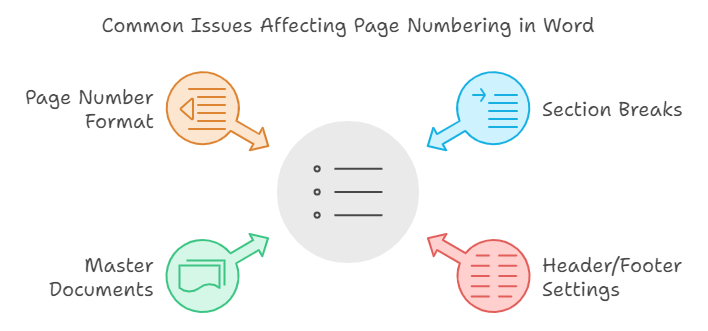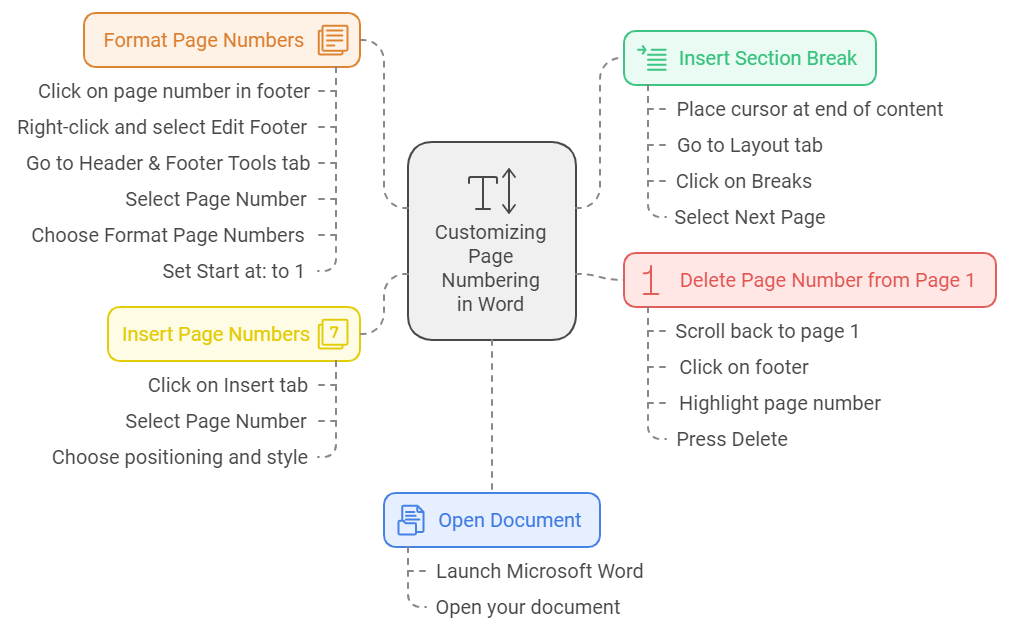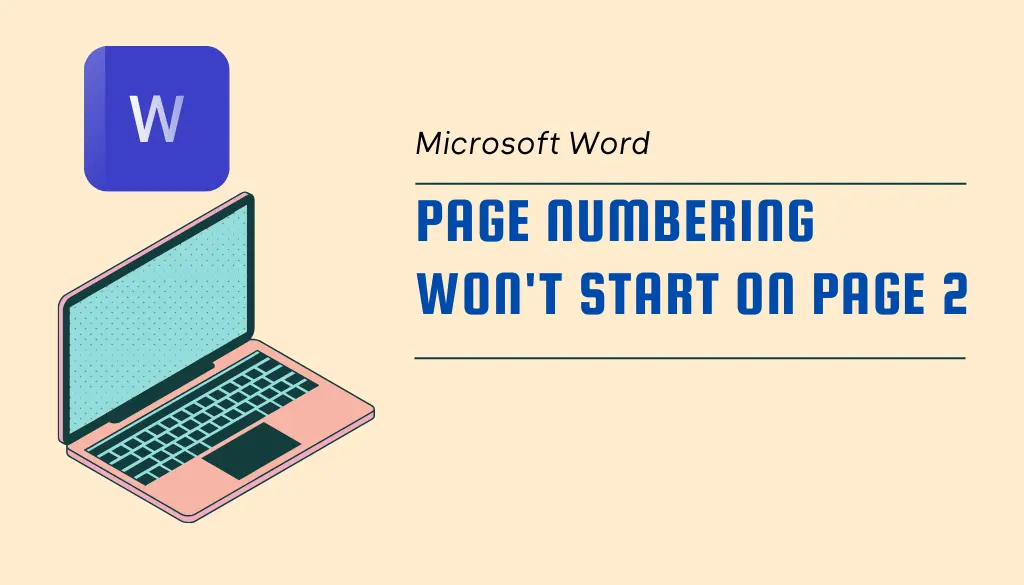Last Updated: January 24, 2025
If you’ve ever tried to create a professional-looking document in Microsoft Word, you know how important it is to have your page numbers formatted correctly. Imagine putting in hours of work only to find that the Microsoft Word page numbering won’t start on page 2, leaving your first page blank or unnumbered. This can be frustrating, especially when you need to present a polished document for a report, essay, or any important project.
But don’t fret! In this article, we will dive into the ins and outs of Microsoft Word’s page numbering functions, helping you quickly identify common issues that cause this numbering glitch. We’ll also provide a simple step-by-step guide to fix the problem so that you can easily customize your page numbering to begin on page 2.
Whether you are a seasoned Word user or a beginner, our guide will empower you to take control of your document formatting and make sure your work shines just as it should! Let’s get started and ensure your page numbering looks exactly the way you want it.
Table Of Contents
Understanding Microsoft Word Page Numbering Functions
When you’re working on a document in Microsoft Word, page numbering is an essential feature for organizing your work. However, many users face issues when they want to start numbering from page 2. The common frustration is that the Microsoft Word page numbering won’t start on page 2, causing confusion and interruptions in the document flow. Here, we will explain how Microsoft Word handles page numbering settings and discuss common issues that might arise.
Default Page Numbering Settings in Microsoft Word
Microsoft Word is designed with default settings that automatically apply page numbers starting from the very first page of your document. This default functionality is good for most scenarios, particularly when you want all pages numbered sequentially. Here are some key points about the default page numbering settings:
- Sequential Numbers: By default, page numbers start from 1 on the very first page.
- Header or Footer: You can decide where to place the page number — in the header or footer of your document.
- Different on First Page: You can choose to have no page number on the first page while keeping them on the subsequent pages.
This default behavior means that the page numbering system automatically assumes you want to start from page 1 unless instructed otherwise. This can create problems when creating reports, essays, or books where the first page (like a title page) doesn’t need a number.
Common Issues That Cause Page Numbering Not to Start on Page 2
If you’ve found that your Microsoft Word page numbering won’t start on page 2, there could be several reasons behind this issue. Awareness of these common issues can help you troubleshoot more effectively:
- Not Using Section Breaks: If your document has sections, Word treats them differently. Without properly configured section breaks, the numbering might continue from the first page.
- Incorrect Header/Footer Settings: Sometimes, page numbers may appear in the wrong section or not at all if your header/footer setting is not correct.
- Using Master Documents: Master documents can complicate page numbering as they may not always sync the way you intend them to with subdocuments.
- Page Number Format Errors: Issues may arise if the format of page numbers is not set correctly in the Page Number settings.

Understanding these problems can save you time and frustration when you’re trying to get the page numbering right in your Word document.
How to Check Your Page Numbering Settings
To determine why the page numbering isn’t starting from page 2, follow these simple steps:
- Open Your Document: Start by opening the document you’re working on.
- Go to Insert: Click on the Insert tab in the toolbar.
- Select Page Number: Choose the Page Number option to see how it’s set up.
- Format Page Numbers: Make sure that the Format Page Numbers option is set correctly. Look for Start at settings and modify them if necessary.
- Check Header/Footer Options: Double-click on the header/footer area to check what settings are affecting your page numbering.
With these checks, you can identify any simple oversights and correct the page numbering problem before applying any fixes.
Tips for Fixing Page Numbering Issues
If your Microsoft Word page numbering won’t start on page 2, here are some helpful tips:
- Use Section Breaks: To keep different parts of your document organized (like title pages and content pages), use Next Page section breaks. This allows you to modify the header/footer in that section independently.
- Set Headers/Footers to ‘Different First Page’: When you create a new section, check the box that says Different First Page in the header/footer options. This means the first page will have no number.
- Restart Page Numbering: In case of multiple sections, ensure you restart pages accordingly by choosing the right section in the Format Page Numbers option.
- Use Page Number Format Options: Make sure to check the Format option whenever customizing page numbers. Set it to continue from the previous section or start at a specific number.
These tips will not only help in ensuring accurate page numbering but also improve the overall presentation of your document. Regular maintenance of document formatting can save a great deal of time in future edits.
Understanding the Tools and Features in Word
Getting familiar with the tools available in Microsoft Word can make managing page numbers much easier. The Microsoft Support page offers in-depth tutorials on dealing with headers, footers, and page numbering which can further assist you.
By grasping how to navigate the functionalities of Microsoft Word, you can troubleshoot issues effectively and ensure that your document presents itself professionally from the start of page 2. Thus, you’ll be able to improve not just page numbering but the layout and overall readability as well.
Step-by-Step Guide to Fix Page Numbering in Microsoft Word
Fixing your Microsoft Word page numbering that won’t start on page 2 can seem tricky, but with a step-by-step guide, it becomes easy. Here’s how you can customize your page numbering and troubleshoot any issues that arise.
How to Customize Page Numbering to Begin on Page 2
Follow these simple steps to start your page numbering on page 2 in Microsoft Word:
- Open Your Document: Launch Microsoft Word and open your document where you want to change the page numbering.
- Insert a Section Break:
- Place your cursor at the end of the content on page 1.
- Go to the Layout tab.
- Click on Breaks and select Next Page under Section Breaks. This creates a new section starting on page 2.
- Insert Page Numbers:
- Click on the Insert tab.
- Select Page Number from the drop-down menu.
- Choose your preferred positioning and style for the page number.
- Format Page Numbers:
- Once you’ve inserted the page numbers, click on the page number in the footer.
- Right-click and select Edit Footer.
- Go to the Header & Footer Tools tab that appears.
- Select Page Number again, then choose Format Page Numbers.
- In the dialog box, set Start at: to 1 (this will make page 2 become numbered as 1).
- Delete Page Number from Page 1:
- Scroll back to page 1 and click on the footer.
- Highlight the page number and press Delete. Now, page numbering should correctly reflect starting at 1 on page 2.

Tips for Troubleshooting if Page Numbering Still Won’t Start on Page 2
If your Microsoft Word page numbering won’t start on page 2 after following the steps above, consider these troubleshooting tips:
- Check the Section Break: Ensure that you have inserted the section break correctly. If you don’t see it, go to the View tab and click on Navigation Pane to check for hidden breaks.
- Verify Footer Settings: Make sure the footer for the first section is not linked to the footer in the second section. Click on the footer on page 2, check if the Link to the Previous is highlighted, and if so, click it to disable it.
- Review Page Number Properties: Right-click the page number, select Format Page Numbers, and double-check that it’s set to start at 1. Sometimes, simple mistakes can cause confusion.
- Restart Microsoft Word: Sometimes all you need is a quick restart. Save your document, close Word, and reopen it. This can clear any temporary glitches.
- Update Microsoft Word: If your software is outdated, it may lead to bugs. Check for updates and install any available updates through the Account tab in Word.
By following these steps and tips, you should be able to fix any issues with Microsoft Word page numbering not starting on page 2. Remember, practice makes perfect, so don’t hesitate to try these steps a few times until you feel comfortable with them.
For more in-depth help with Microsoft Word and its features, check out resources like Microsoft Support.
Summary of the Steps
| Step | Action |
|---|---|
| 1 | Open your document. |
| 2 | Insert a section break after page 1. |
| 3 | Insert page numbers. |
| 4 | Format page numbers to start at 1. |
| 5 | Delete the page number from page 1. |
Conclusion
Fixing the issue of Microsoft Word page numbering not starting on page 2 can be a straightforward process once you understand the tools and settings within the program. By grasping how page numbering works and the default settings in Microsoft Word, you can navigate the common pitfalls that many users encounter.
The step-by-step guide provided in this article offers a simple yet effective method to customize your document, ensuring that your page numbering begins exactly where you want it to. Remember to check for any sections, headers, or footers that might disrupt your numbering.
If you follow the steps carefully but still find that your Microsoft Word page numbering won’t start on page 2, don’t hesitate to utilize the troubleshooting tips mentioned. Addressing formatting issues or checking for hidden settings can make all the difference.




Pingback: Pro Tips: Word 365 Co-Authoring Hacks for Real-Time Collaboration | MSW Tutor.